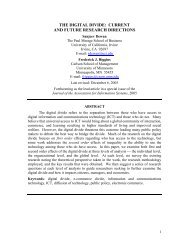Agent-Based Modeling to Inform Online Community Theory and ...
Agent-Based Modeling to Inform Online Community Theory and ...
Agent-Based Modeling to Inform Online Community Theory and ...
You also want an ePaper? Increase the reach of your titles
YUMPU automatically turns print PDFs into web optimized ePapers that Google loves.
off-<strong>to</strong>pic subjects. We operationalize benefit from group identity as a function of the similarity be-<br />
tween an agent’s interest <strong>and</strong> the community’s interest, calculated as the percentage of viewed<br />
messages that correspond <strong>to</strong> the agent’s interests. The higher the percentage, the greater level of<br />
identity-based attachment the agent feels <strong>to</strong> the community.<br />
Benefit from bond-based attachment. Research on small groups suggests that repeated interac-<br />
tion leads <strong>to</strong> interpersonal attraction (Festinger et al. 1950). As the frequency of interaction be-<br />
tween two persons increases, their liking for one another also increases (Cartwright <strong>and</strong> Z<strong>and</strong>er<br />
1953). Studies of Usenet groups suggest that getting a quick reply after posting seems <strong>to</strong> encourage<br />
members of an online community, especially newcomers, <strong>to</strong> return <strong>and</strong> participate in community<br />
discussion (Kraut et al. 2007). We speculate that replies from other members signal the likelihood<br />
of forming relationships with others in a community. We thus calculate the benefit an agent rece-<br />
ives from interpersonal bonds as a function of the number of other agents with whom the agent has<br />
developed a relationship through repeated, mutual interaction (i.e., the two agents have responded<br />
<strong>to</strong> each other at least twice) <strong>and</strong> the number of responses the agent has received during the last pe-<br />
riod of interaction, whichever is higher. Because both attitude similarity (Byrne, 1997) <strong>and</strong> person-<br />
al self-disclosure (Collins & Miller, 1994) lead <strong>to</strong> liking, the two interacting agents will like each<br />
other more if they have similar interests or if the interaction involves off-<strong>to</strong>pic subjects. Benefit<br />
from interpersonal bonds takes a marginally decreasing form, as illustrated in Table 2: The first few<br />
relationships an agent develops bring greater social benefit than subsequent ones.<br />
2.2.3. Benefit from recreation. A third motivation that leads people <strong>to</strong> join online com-<br />
munities is recreational, that is, the enjoyment members derive from reading <strong>and</strong> posting online<br />
(Ridings <strong>and</strong> Gefen 2004). Several studies have identified stable individual differences in the extent<br />
<strong>to</strong> which people think online behavior is fun (e.g., Cotte et al. 2006). For instance, posters enjoy online<br />
interaction more than lurkers do (Preece et al. 2004). Our model captures these individual differences<br />
by drawing an agent’s interest in reading <strong>and</strong> posting r<strong>and</strong>omly from a right-skewed gamma distri-<br />
bution (as illustrated in Table 2). With a gamma distribution, the majority of members have a mod-<br />
16
















